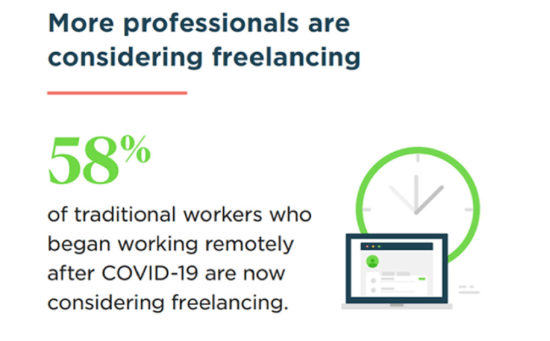What is the Freelance Economy?
Statistics show that more and more workers are ditching the traditional corporate 9-to-5 in favour of self-employment as the gig economy continues to gather steam. It is estimated that around 1.56 billion people, which is about 46.5% of the global workforce are self-employed many of whom are online freelancers.
An article titled “What Is The $1.2 Trillion Dollar Freelance Economy?” by Matthew Mottola published on Forbes.com last year defines the term ‘Freelance Economy’ as “Independent Contracting Made Easier Through Software”. He declares that over half of your talent will choose self-employment in the next 5 years, and of those that stay employees, a good amount will freelance on the side.
Freelance economy is enabled by the following three technology disruptions: a) The internet making it possible to connect with anyone in the world, b) Remote tools making it possible to collaborate with anyone in the world, and c) Workflow (contracting, payment, project management) tools making it possible for freelancers to run scalable and profitable one person businesses.

Why Bhutan should take freelancing seriously
Our small population and therefore small market size for whatever products or services we provide is a major limitation for the growth of our domestic businesses as well as self-employment opportunities. Even our so called big business tycoons have little opportunities to scale beyond certain limit unless they become capable of taking on the market beyond Bhutan. On the other side of the spectrum, talented individuals like artists, graphic designers, architects, programmers and website developers who operate on their own also find the small market we operate in stifling and discouraging.
Against this backdrop, the rising global freelance economy holds a great potential to bring self-employment opportunities to many skilled Bhutanese youths who are not able to make a living.
We realized this way back in 2013, and Thimphu TechPark formed a working group to study the potential in collaboration with MoLHR and MoIC which recommended a pilot training. In 2016, MoLHR in collaboration with a Danish company called Coderstrust and the Royal Institute of Management provided the training on freelancing. Few participants from the training became successful freelancers who encouraged others to follow the path. Most recently, DHI BizAp has focused on training youths to become successful freelancers, and now, it is encouraging to note that there are a good number of successful freelancers already.
We have to build on this and encourage other youths who find it hard to get regular jobs to take up freelancing. While doing so, we should let the youths know that it is not easy to find freelancing jobs in the beginning since the jobs normally go to those who have built up a good track record of delivering projects successfully. But once you persevere and deliver few works successfully, future works would be easier to come by. It is no different in the real world. You need to have a good track record to get hired and paid.
Evolution of Freelance Economy – the shift from gig work to big work
The freelance economy in current form started around 1998 when Elance was founded. Elance merged with Odesk in 2013 and in 2015 became Upwork. Upwork went for IPO and got listed on NASDAQ in 2018 while Fiverr also went for IPO and got listed on NYSE in 2019.
Freelance Forward Economist Report 2021 stated that, amid the COVID pandemic, Freelancers contributed $1.3 trillion to the U.S. economy in annual earnings, up $100 million from 2020.
According to Forbes.com, “the largest shift currently underway is the shift from transaction based ‘gig’ work to large ‘core to the business’ projects”, which Tim Sanders, Upwork’s VP Customer Insights calls “the shift from gig work to big work”.
Freelancing Platforms
Freelancing platforms connect freelancers to employers for temporary work, and they take a commission for their services which can be around 20%. Thousands of works are posted on these platforms everyday. According to seeking Alpha, Upwork is the market leader, but only by a very small margin, with 9% of the market share. It’s closely followed by Toptal (8%) and Fiverr (5%). Among Bhutanese freelancers, the most popular platforms seem to be upwork.com, fiverr.com and freelancer.com. Other well-known freelancing platforms are Hired.com, PeoplePerHour.com, codester.com, gagster.com, Codecanyon.net, Freemius.com etc,
Freelancing skills in demand
A survey by Paypal found that 36% of businesses use freelancers for web design projects, making this the most in-demand freelancing skill. A further 31% use freelancers for programming, which ranked second. Other popular skills included graphic design and illustration (30%), web/mobile development (26%), and marketing and sales (24%).But besides these, all kinds of skills are in demand on the freelancing platforms – acting, making videos, editing videos, data entry etc. You name it, it is there.
A Bhutanese lady who earned about USD 2000 through fiverr.com and has reached level 2 shared: “As a new seller on fiverr, I basically did whatever I got on my plate. You have no luxury of choosing the type of work or clients as a beginner. However, once your level goes up and get good reviews on your profile, you can choose to do the work you like. So, I followed that advice and did whatever I got. I worked on projects such as video making, editing, 2D animation ads, presentation, voice over, acting, web development, translation, and shooting short cooking videos”.
How do you get started as a freelancer?
Firstly, you need to sign up on one of the platforms such as upwork.com or fiverr.com.
Next, learn how to do become a successful freelancer on these platforms by searching online and watching Youtube videos dedicated to that. There are also courses on udemy.com for freelancing. These days, DITT has been providing udemy accounts to certain groups to help them upskill themselves. If you are one of them, take the opportunity to search for freelancing courses and take them. If you have the opportunity, try to enrol yourself in a course like DHI BizAp program, or one of the relevant courses offered by MoLHR or Desuung Skilling Program.
Thirdly, try to meet up with successful freelancers and learn from their practical experience. Follow in their footsteps and start earning for yourself.
How do Bhutanese freelancers get paid?
Almost all Bhutanese freelancers receive payment through a Payoneer Card (www.payoneer.com). The money you earn gets deposited into your Payoneer card. It is based on Master Card. A freelancer told me that you can use it make online purchase from any online store as long as that store accepts the Master card. But you can also withdraw money using your Payoneer Card from a Bank ATM in Bhutan. But there are certain deductions for the service.
Future outlook for freelancing and Bhutan
Freelancing is here to stay and become even bigger in the years to come. For a small economy like Bhutan, this is a great opportunity for our youths to work for the global market from the comfort of our peaceful nation. Let us empower our youths to avail this beautiful opportunity.


